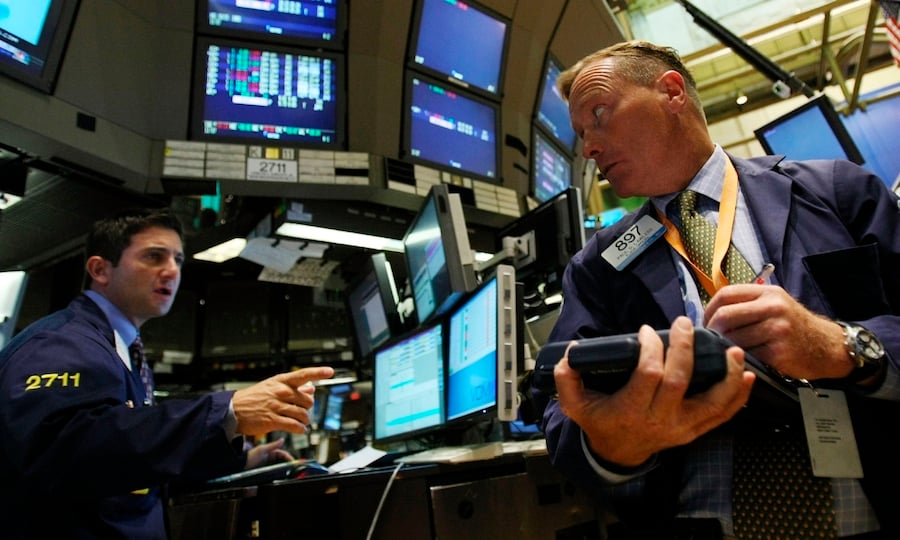Central-bank stimulus and a clutch of strong earnings from the tech sector pushed the S&P toward its best monthly gain since 2011 and close to its all-time high.
Central-bank stimulus and strong earnings from the largest technology companies combined to give U.S. stocks their fourth straight weekly gain and propel the S&P 500 Index toward its best month since 2011.
The S&P 500 has jumped 11% from its summer low, with the surge in October led by commodities producers and technology shares, the very groups that fueled the August selloff. The gains put U.S. equities back in the black for the first time since the correction, and left the benchmark index just 2.6% from its all-time high.
“Stocks are back,” said Robert Pavlik, who helps oversee $9.1 billion as chief market strategist at Boston Private Wealth. “We're back on track as far as a cheap money, quantitative easing, risk-on trade is concerned.”
LONGEST STREAK
The S&P 500 rallied 2.1% in the five days to 2,075.15, for a fourth weekly gain that is the longest streak of the year. The gauge closed at the highest since Aug. 19. The Nasdaq 100 Index surged 4.2% for its best week since July.
Equities got a boost during the week from central banks. On Friday, the People's Bank of China cut interest rates and banks' reserve requirements to support a slowing economy. That announcement came a day after the European Central Bank signaled it will bolster stimulus if needed.
Meanwhile, the earnings season suddenly came to life. More than 100 companies in the S&P 500 reported for the week, initially providing mixed messages until results from three tech giants late Thursday sparked a broad rally. Microsoft Corp., Google parent Alphabet Inc. and Amazon.com Inc. added more than $80 billion in combined market value the next day as quarterly profit topped estimates. A group of tech stocks in the gauge surged 4.6% in the week to a 15-year high.
The combination of earnings growth and central bank stimulus — two of the biggest supports for equities during the 6 1/2 year bull market — provided an accelerant to stocks in the midst of recovering from the first correction since 2011. All 10 of the major groups in the S&P 500 have rallied since Aug. 25, led by gains of more than 16% for technology and energy stocks.
With the summer selloff fading away, volatility has also diminished. The Chicago Board Options Exchange Volatility Index has tumbled more than 60% after spiking to the highest in almost four years during the S&P 500's summer swoon. The volatility measure has been below 20 for 15 straight days. Prior to that, it traded above that level for 30 sessions, the longest such streak since January 2012.
“There's likely to be continued policy support from central banks around the world and the headwinds, particularly the slowdown in China's growth, may be behind us. Investors can take some comfort in that,” said Brian Jacobsen, who helps oversee $250 billion as chief portfolio strategist at Wells Fargo Advantage Funds. “On top of that, earnings that came out, particularly from the Holy Trinity of Big Tech, were great. There were a lot of things that lined up nicely for us this week.”
NOT ALL SMOOTH
Not everything went smoothly during the week. Valeant Pharmaceuticals International Inc. took the market on a wild ride Wednesday, plunging as much as 40% after a stock-commentary site run by short seller Andrew Left questioned the company's sales practices. Valeant called the accusations “erroneous” and denied the report. Other health-care companies took a battering, with Endo International Plc and Tenet Healthcare Corp. falling more than 16% for the week.
And while the S&P is up 8.1% in October, on track for the best month since 2011, it has yet to recoup all of its losses from August, let alone reach its record from May. Meanwhile, the Russell 2000 Index of small-cap stocks is 10% below its 2015 peak.
There's the possibility of further choppiness, which means it's probably not “onward and upward from here,” according to Leo Grohowski of BNY Mellon Wealth Management in New York, especially with the Federal Reserve still debating the timing for higher interest rates.
“It's been sort of a relief rally, rather than an indication of renewed optimism,” said Mr. Grohowski, who helps manage more than $183 billion in client assets as chief investment officer of BNY Mellon Wealth Management. “My growing concern is the equity market participants here in the U.S. are still too complacent around December and there being a less than a 50-50 chance of a rate liftoff.”
The Fed is scheduled to meet in the coming week and the probability of a boost to interest rates before January is 36%. Mixed economic data and volatile financial markets kept the Fed from tightening last month.
U.S. economic reports were generally positive this week. Robust housing reports suggested U.S. growth may be getting support from the real-estate market. Meanwhile, jobless claims fell near the lowest level in four decades, though Americans' expectations for the economy deteriorated to a 13-month low in October.
On the whole, it was a “rewarding week” as the market returned to positive territory for the year, said Mr. Grohowski.







